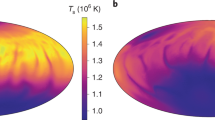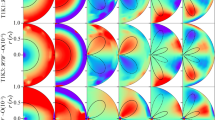Abstract
GOLD1 has proposed an interesting model for pulsars, which goes a long way towards explaining some of their more baffling properties. His model, briefly, is that pulsars are rapidly rotating neutron stars, with an axially asymmetric magnetic field “frozen in” to the star, and thus rotating with it. A plasma surrounds the star and co-rotates with the magnetic field, out to, or nearly out to, the critical radius at which the tangential velocity would be the velocity of light. Relativistic effects in this rapidly spinning plasma are to account, in a general way, for the radiation emitted. The exact mechanism is not specified, although charges embedded in the plasma are mentioned.
This is a preview of subscription content, access via your institution
Access options
Subscribe to this journal
Receive 51 print issues and online access
$199.00 per year
only $3.90 per issue
Buy this article
- Purchase on Springer Link
- Instant access to full article PDF
Prices may be subject to local taxes which are calculated during checkout
Similar content being viewed by others
References
Gold, T., Nature, 218, 731 (1968).
Author information
Authors and Affiliations
Rights and permissions
About this article
Cite this article
GOOD, M. Proposed Test for the Radiation Mechanism of Pulsars. Nature 221, 250–251 (1969). https://doi.org/10.1038/221250a0
Received:
Issue Date:
DOI: https://doi.org/10.1038/221250a0
This article is cited by
-
Nature of the radio wavelength emission from pulsars
Astrophysics (1974)
Comments
By submitting a comment you agree to abide by our Terms and Community Guidelines. If you find something abusive or that does not comply with our terms or guidelines please flag it as inappropriate.



